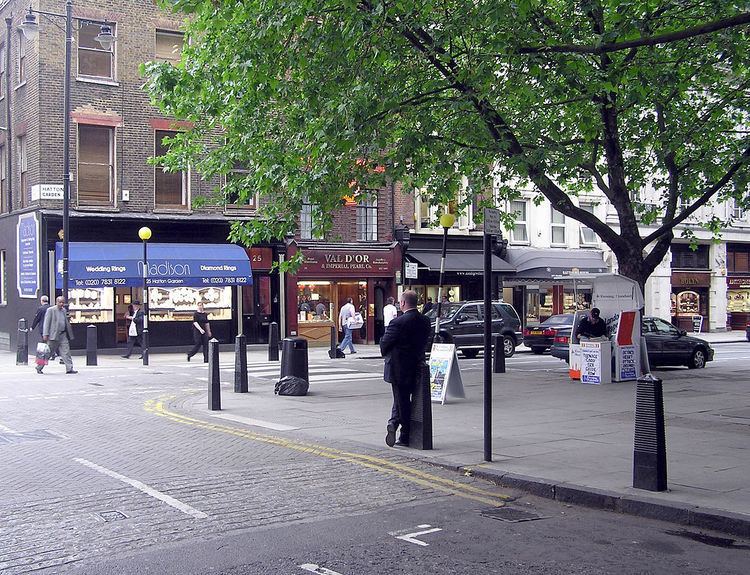Major cities London | ||
 | ||
Similar Farringdon station, Chancery Lane tube station, Ye Olde Mitre, London Underground, Bloomsbury Square | ||
Hatton garden jewellery jewellers all at hattongarden com
Hatton Garden is a street and area in the Holborn district of the London Borough of Camden. It is noted as London's jewellery quarter and centre of the UK diamond trade, but is now home to a diverse range of media and creative businesses.
Contents
- Hatton garden jewellery jewellers all at hattongarden com
- Map of Hatton Garden London EC1N UK
- Crime
- Street names etymologies
- Hatton Garden in fiction
- References
Map of Hatton Garden, London EC1N, UK
The name 'Hatton Garden' is derived from the garden of Ely Place, the London residence of the Bishop of Ely, which was given to Sir Christopher Hatton by Elizabeth I in 1581, during a vacancy of the see.
The area surrounding Hatton Garden has been the centre of London's jewellery trade since medieval times. The old City of London had streets, or quarters, dedicated to types of business, and the area around Hatton Garden became a centre for jewellers and jewellery. Nearly 300 businesses in Hatton Garden are in the jewellery industry and over 55 shops represent the largest cluster of jewellery retailers in the UK. The largest of these companies is De Beers, the international family of companies that dominate the international diamond trade. De Beers has its headquarters in a complex of offices and warehouses just behind the main Hatton Garden shopping street. The area also plays host to a large number of media, publishing and creative businesses, including Blinkbox and Grey Advertising.
Hatton Garden has an extensive underground infrastructure of vaults, tunnels, offices and workshops.
Hatton Garden was also the home to the invention of the machine gun. Sir Hiram Maxim had a small factory at 57 Hatton Garden and in 1881 invented and started to produce the Maxim Gun, capable of firing 666 rounds a minute.
The nearby streets including Hatton Place and Saffron Hill have become more residential in recent years with the building of several blocks of 'luxury' apartments, including Da Vinci House situated in the former "Punch magazine" printworks and the architecturally distinctive Ziggurat Building.
Ely Place, off Hatton Garden, is home to St Etheldreda's Church – one of the oldest Roman Catholic churches in England and one of only two remaining buildings in London dating from the reign of Edward I. A building with statues of charity school children is a former chapel and parish school, now known as Wren House.
In 1962, Lawrence Graff of Wittelsbach-Graff Diamond fame, opened the first retail jewellery store here.
Crime
In July 1993 thieves stole £7 million worth of gems belonging to the jewellers Graff Diamonds - it was London's biggest gem heist of modern times.
In April 2015, an underground safe deposit facility in Hatton Garden area was burgled in the Hatton Garden safe deposit burglary. The total stolen may have had a value of up to £200m, although court reports referred to a lesser figure of £14m. The theft was investigated by the Flying Squad, a branch of the Specialist, Organised & Economic Crime Command within London's Metropolitan Police Service, leading to the arrests and March 2016 convictions of seven perpretators.
Street names etymologies
Hatton Garden has no formally defined boundaries - those utilised here are: Clerkenwell Road to the north, Farringdon Road to the east, Holborn and Charterhouse Street to the south and Gray's Inn road to the west.
Hatton Garden in fiction
Michael Flanders and Donald Swann (humorists of the 1960s and 1970s) celebrated Hatton Garden's connection with the jewellery trade in their song of a sewage worker, "Down Below":
Hatton Garden is the spot, down below Where we likes to go a lot, down below, Since a bloke from Leather Lane, Dropped a diamond down the drain, We'll be going there again, down below.Hatton Garden features in the 1967 children's novel Smith by Leon Garfield, where the main character tries to elude two pursuers through the crumbling streets of 18th century Holborn.
The Avengers, Season 2, Episode 10, "Death on the Rocks," is set in the diamond business in Hatton Garden.
